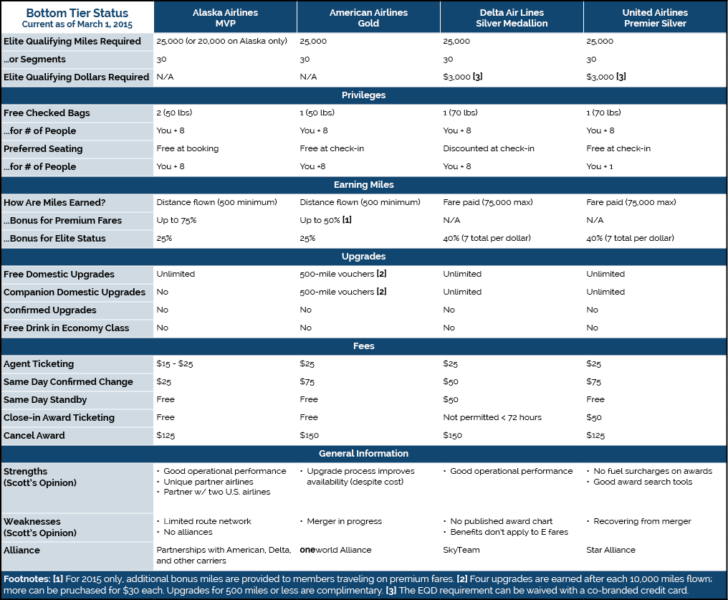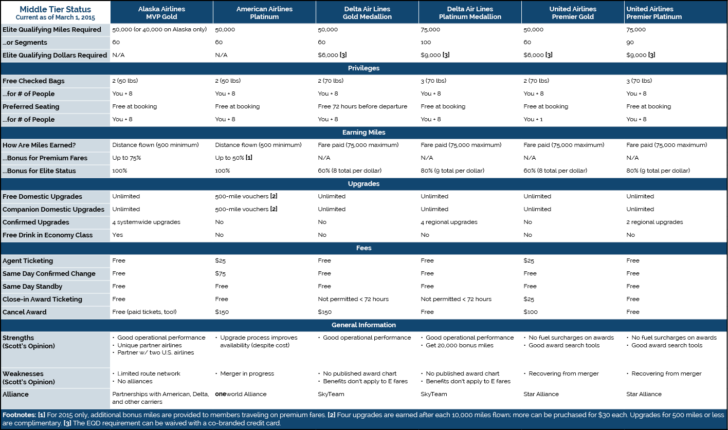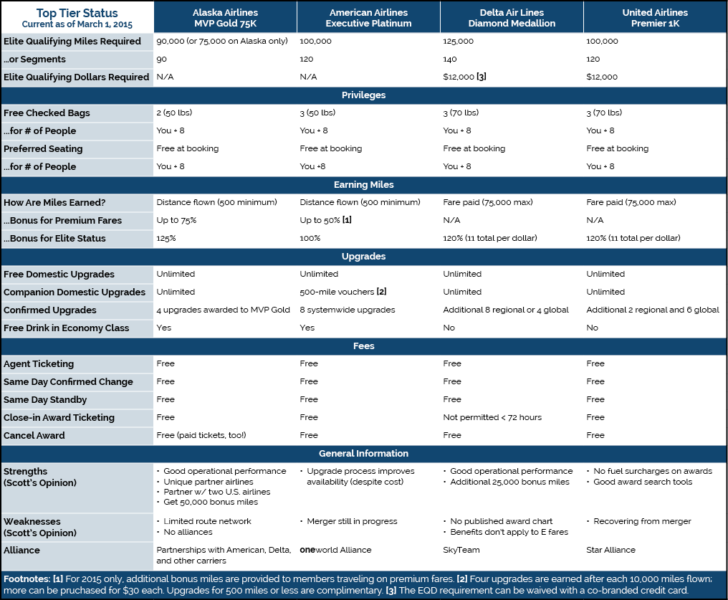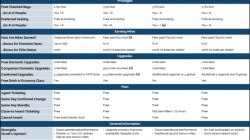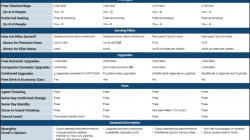As I did earlier this week for the best hotel loyalty programs, it’s now time for the third annual comparison of airline loyalty programs! A lot has changed since last year’s edition, and I put off this project for many reasons. It’s intimidating. I’m sure I got something wrong. And not all the changes I mention have been implemented yet; this information is current as of March 1. United’s new revenue-based earning system doesn’t take effect until then, and American’s integration with US Airways provides only vague milestones. Still, I hope that some information is better than none.
Information is organized into three tables for bottom, middle, and top tier status. Where there is more than one middle tier, I’ve included them side-by-side. That’s why this table is much larger. You can click on the images to zoom or download all three as a PDF.
Comments are always welcome. If you point out an error, I’ll wait to collect them all and get them corrected by the end of the week. (Last updated February 21, 2015.)
Notable Changes from Last Year’s Review of Airline Loyalty Programs
US Airways is dead to me. Consolidation makes my life easier, and I’m not including it this year even though they continue to exist in the eyes of the federal government.
I consolidated some of the fees and benefits. Do you really care about the difference between an award change fee and an award cancellation fee? Likely not. United has dozens of rules that determine which one applies. Alaska just waives them all once you reach MVP Gold status. If you really need to know, post your question in the comments.
I took out all the information on priority boarding, check-in, etc. In theory your status makes a difference. In practice, the first two boarding groups are 50 people deep thanks to all the credit card holders. Unless you’re going to be gate lice or make a scene at check-in, even a top tier member is unlikely to be first in line.
Caveats to Remember
Airline loyalty programs are complicated beasts. The fee information is the worst. If I got something wrong, I’m not trying to mislead people. Just point out the error so I can correct it. Links are helpful.
Sometimes I have to simplify complex rules. Maybe certain routes are excluded from an upgrade, or there are alternative rewards that you can choose instead of bonus miles. I know this. I just can’t fit all those rules into a table. Feel free to add context in the comments, but I am less likely to incorporate those changes into an updated draft.
Some other airlines, including Southwest and JetBlue, offer good benefits. But they are so very different in the onboard amenities and frequent flyer benefits that they offer that I just can’t compare them using the same standards. I have a hard enough time comparing Delta and United to American and Alaska.
Comparing Bottom Tier Elite Status
Executive Summary: At the lowest tier, many readers would be better served by just getting a co-branded credit card that comes with a free checked bag and priority boarding. Alaska is the only carrier that doesn’t offer these benefits with its credit card, though the $99 companion fare is arguably more valuable. Alaska also has lower fees.
There are no great choices here, so let’s focus on the negatives. United only allows you and one other person to get a preferred seat (the other allow eight companions). Delta doesn’t provide preferred seating for free under any circumstances, even if they’re still available at check-in.
Comparing Middle Tier Elite Status
Executive Summary: MVP Gold status is the best mid-tier status on the planet. In exchange for flying as few as 40,000 miles you enjoy waivers for almost any kind of fee. You can even cancel a paid ticket any time before departure and use the full credit for another flight.
But American, Delta, and United make more sense for people who aren’t on the West Coast or who have some significant international travel. (While Alaska has many international partners, they aren’t alliance members and don’t offer any special benefits.) In this case, I would pick American’s Platinum status at the 50,000-mile level for the 500-mile upgrades, which let you focus on the routes you want, and the 100% bonus on award miles. If you can fly 75,000 miles a year, then Delta is the winner. I’m not happy about their restrictive policies for using miles, but they offer more regional upgrades and make it easier to get a waiver from the minimum spend requirement.
Comparing Top Tier Elite Status
Executive Summary: Alaska suffers because they don’t have an extensive international network, although they do offer the most bonus miles for elite status as well as an additional 50K just for qualifying. It’s painful to earn all those miles flying on domestic routes, but at least there are good international partners on which to redeem them. I think American still takes the cake as the best program. There’s no minimum spending requirement, and the upgrades are very easy to use even if they aren’t always free. New changes to the same-day change policy were desperately needed.
Delta and United look about the same. I’d still pick United for its more generous loyalty program. They have a published award chart, a search tool that (usually) works, and flexible routing rules.


